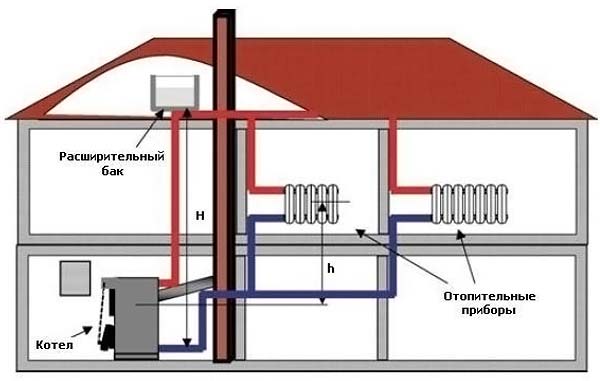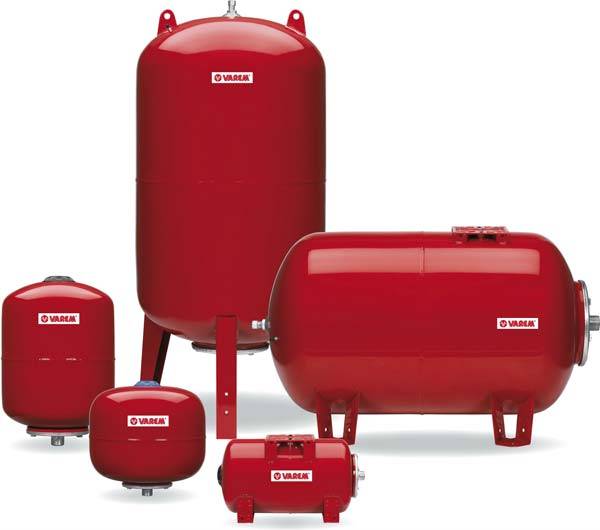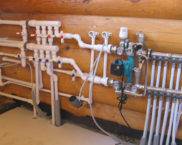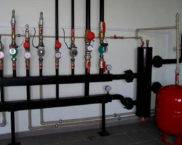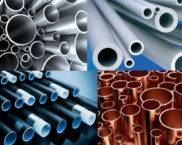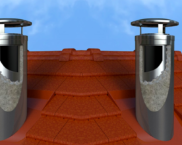Heating scheme of a 2-storey private house with and without a water pump
Autonomous heating systems, which are used in private houses, have undoubted advantages over centralized systems: they are controllable and economical. Only the owners of private houses can independently regulate the intensity of heating, connect additional circuits and install the type of radiators that they like. The heating scheme of a 2-storey private house must meet not only operational requirements, but also be trouble-free, economical, simple and durable.
The content of the article [Hide]
Heating of cottages - types of systems and equipment requirements
The choice of the heating scheme is mainly influenced by the area of the heated rooms, that is, the total length of the pipeline. The main task of any heating system is uniform heating of premises along the entire length of the pipeline. If in small one-story houses organizing such a system is not a big deal, then in cottages with two levels to solve the same problem, you need to make serious calculations.
Any heating system consists of the main elements:
Video: heating scheme for a two-story house

Systems with circulation pump installation
Any heating scheme for a 2-storey private house must ensure constant circulation of the coolant through the system. At the same time, the efficiency and speed of heating the premises directly depends on the level of hydraulic pressure in the pipes. Obviously, the simplest solution to this problem is a circulation pump.
Pumping schemes are good in that with the help of a small and economical pump, a given pressure is provided in the system, and hot water will be delivered to any point in the circuit, regardless of its location. The power consumption of such a device is from 25 to 50 W per hour. Even with daily continuous work per month, the meter will wind no more than 40 kW, which does not significantly affect the consumption of the family budget. This circuit has a serious drawback - it does not work in the event of a power outage. Unfortunately, such situations are not uncommon in Russia, so in winter it is necessary to have at your disposal alternative power supplyso as not to be left without heat at all.
Systems based on natural circulation
Knowing the basics of thermodynamics, you can develop such a heating scheme that a pump is not needed at all. This scheme is based on the ability of the heated liquid to rise upward. A boiler or stove located at the level of the first floor heats water, this water rushes upward, starting the process of movement of the coolant through a closed pipeline system.
In systems without circulation pumps, it is impossible to provide high pressure, because its level depends on the temperature of the liquid. For this reason, systems with natural circulation have their own characteristics:
Advantages and disadvantages of working schemes
Pumping systems have clear advantages in the form of continuous operation, guarantee of efficiency and ease of installation. The main disadvantage is the volatility of the equipment. Circuits with natural circulation can be called truly autonomous, but in this way it will be possible to heat a limited area, and the heating process will take much longer. The installation of such systems is a complex and painstaking business, the preliminary calculation must be performed very accurately.
There are various alternative schemes, including a combined one, when one of the circuits is supplied with a circulation pump. These are complex systems that are used in large-area houses, for residential two-storey house they are rarely advisable.
Wiring types and calculation methods
To calculate heating systems, many factors must be taken into account, including:
In accordance with the specified parameters, according to the SNiP tables, you can calculate the required power boiler and the required system pressure.
Common concepts
For small houses of one or two floors, the simplest one-pipe schemes are suitable, which are easy to install and calculate, can work without a pump, but are considered the least effective.
An improved circuit - the so-called "Leningradka" - a system in which each radiator is connected in parallel, and control valves allow more efficient heat consumption and redirect hot water.
The principle of operation of a two-pipe system is that heated water is supplied to all radiators at the same time, and its temperature is the same at each inlet. The cooled water is discharged through the return pipe, which is also common.
There are bottom and top feed schemes. In the first case, water, rising up the riser, first supplies the first floor, and then the second. With the upper system, the opposite is true: heated water rises through the common riser and then is fed to the radiators of the upper floors, cooled and returned back.
Open and closed expansion tank circuits
The expansion tank in the heating system plays the role of a water level regulator, and also insures the system against pressure drops. The expansion tank is usually installed in the coldest place in the system - on the return pipe. It should be located in a heated room to prevent water from freezing in it in winter.
There are two types of cisterns - open and hermetically sealed. Open tanks are used in natural circulation systems, and closed diaphragm tanks are used only in systems with a pump. Read more about expansion tank for closed heating in a separate publication of our portal.
How to choose the optimal scheme
The heating scheme of a small 2-storey private house can be mounted in any of the above ways. The question of whether or not a circulation pump is used is fundamental. More details about the features of each heating scheme can be found in the video below.
Video: heating scheme of a two-story house warm floor + collector heating












